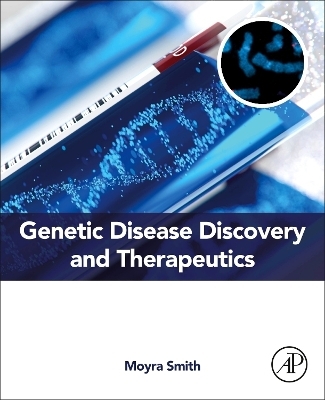
Genetic Disease Discovery and Therapeutics
Academic Press Inc (Verlag)
978-0-443-23648-8 (ISBN)
This book investigates methodologies applied to the characterization of downstream functional effects of specific gene mutations associated with altered phenotypes and clinical disease. It documents evidence of how specific mutations influence pathology and lead to disease manifestations. This book also reviews information on therapeutic approaches that could potentially be applied in diseases due to gene defects. Genetic Disease Discovery and Therapeutics is a valuable reference for scientists and graduate students involved in laboratory research related to genetics, physiology, pathology, and pharmacology as well as clinicians who encounter patients with genetic disorders.
Dr. Moyra Smith is a Professor Emerita in the Department of Pediatrics and Human Genetics, College of Health Sciences, at the University of California, Irvine, and in past years has held appointments at the National Institutes of Health and Johns Hopkins University. In 2017, the UCI Emeriti Association awarded Dr. Smith the UCI Outstanding Emerita Award in recognition of her continuing research on genetics and genomics, strong record of publications, active engagement with programs in the Department of Pediatrics, mentoring of graduate students, and involvement with the CART Autism Center at UCI. Dr. Moyra Smith has published more than 100 scientific articles in peer-reviewed journals such as Frontiers in Molecular Biosciences, Molecular Psychiatry, the Journal of Medical Genetics (JMG), and Cytogenetics Cell Genetics.
Preface
Acknowledgments
I
Disease classification and possible diagnosis
1. Clinical features to consider in a patient with possible genetic disease
Clinical genetics assessment: History and physical examination
Family history information
Resources of information relevant to developmental defects and genetic disorders
Aspects of developmental delay
Movement disorders and cerebral palsy
WHO report on recommendations for community genetic services in low and middle income countries (2010)
References
2. Determining the presence of altered values in clinical laboratory studies
Acutely ill patients in the newborn nursery or patients with possible metabolic disease
Patients with dysmorphology
Organic acidemias, organic acidurias
Clinical utility of genome sequencing
Exome sequencing and diagnostic value in inborn errors of metabolism
Reanalysis of sequence data
References
3. Further laboratory-based investigations for possible gene- or genome-based disorders
Investigations in possible gene or genome-based disorders
References
II
Application of therapies and strategies for development of therapies
4. Review possible therapies to address clinical manifestations including symptoms and signs and abnormal results of metabolic, biochemical, gene-based microarray or chromosome studies
Mitochondrial functions and dysfunctions in mitochondrial disorders
Peroxisomes and genetic disorders involving peroxisomes
Generation of stem cell including hematopoietic stem cells for therapy
Glycogen storage diseases
References
5. Review investigations of possible therapies to address underlying disease-related manifestations
Inherited disorders of vitamin metabolism
Biotin
Vitamin D hydroxylation deficient ricketts
Therapeutic development in specific germline genetic diseases
Range of therapeutic options in lysosomal storage diseases
Lysosomal diseases with abnormal storage of mucopolysaccharides and advances in therapy
Monoamine neurotransmitter disorders and approaches to therapy
Endocrine disorders
Congenital adrenal hyperplasia
References
Further reading
6. Functional impairments, known genetic disorders, and review reports of established and possible therapies for specific genetic diseases
Ciliopathies
Neuronal primary cilia and metabolism
Polycystic kidney disease
Monogenic kidney disease
Inborn errors of immunity
Specific immune disorders
Newborn screening for inborn errors of immunity
Severe combined immunodeficiency
Systemic lupus erythematosus
Alpha-1-antitrypsin deficiency
Achondroplasia
Hypophosphatasia
Hypophosphatasia and hypophosphatemic rickets
Cystic fibrosis
Cystic fibrosis gene mapping and gene product identification
Glycosylation
Biometals
Defects in DNA repair processes
Hearing and deafness
References
III
Discussion of specific diseases where gene therapy, gene-based therapies or small molecule-based therapies have been successful
7. Examples of diseases where appropriate therapies were discovered
Epilepsies: Genetic testing and relevance to treatment
Systemic analysis and reanalysis of exome sequencing data in epilepsy
Ion channel associated disorders
Therapeutic approaches to Duchenne Muscular Dystrophy (DMD)
Hemoglobinopathies sickle cell disease, thalassemia advances in treatment
Treatment of sickle cell disease and beta thalassemia
Alpha thalassemia major
Spinal muscular atrophy
References
Further reading
8. Therapies that address altered gene regulation
Examples of disorders due to altered transcription factor activity
Craniosynostosis
PCSK9 and hyperlipidemia
References
9. Stem cell review research on therapeutic design
Understanding of disease mechanisms in promoting therapeutic design
Stem cells and cell therapies
References
IV
Review research on therapeutic design
10. Review research designed to investigate gene function and possible impact of specific variants
Huntington disease
Treacher Collins syndrome (TCS)
Ribosome biogenesis and ribosomopathies
Vision and hearing: The visual cycle, retina and retinitis pigmentosa
Age related neurodegenerative conditions
APOE4 genetic variant and Alzheimer research
References
11. Designing therapies relevant in human genetic disorders
Designing therapies for specific diseases
Rare diseases, precision medicines, and orphan drug designations
Gene editing
Crispr CAS9 gene editing
Clinical trial designs for rare diseases
Pharmacogenetics pharmacogenomics
References
V
Clinical trials design and permissions
12. Clinical trial designs and permissions
Human subjects research
Bioinformatics and cheminformatics in discovery of new medications
CAR T-cell therapy in auto-immune diseases
Target discovery through genetic studies and development of therapies
References
Index
| Erscheinungsdatum | 16.11.2024 |
|---|---|
| Verlagsort | San Diego |
| Sprache | englisch |
| Maße | 191 x 235 mm |
| Gewicht | 450 g |
| Themenwelt | Informatik ► Weitere Themen ► Bioinformatik |
| Studium ► 2. Studienabschnitt (Klinik) ► Humangenetik | |
| Naturwissenschaften ► Biologie ► Genetik / Molekularbiologie | |
| ISBN-10 | 0-443-23648-8 / 0443236488 |
| ISBN-13 | 978-0-443-23648-8 / 9780443236488 |
| Zustand | Neuware |
| Informationen gemäß Produktsicherheitsverordnung (GPSR) | |
| Haben Sie eine Frage zum Produkt? |
aus dem Bereich


